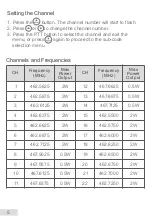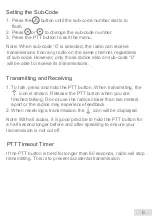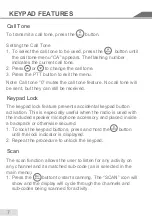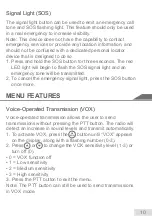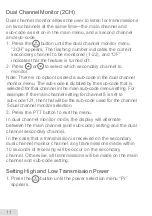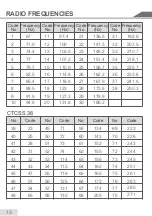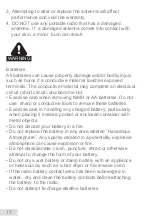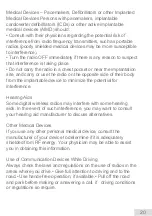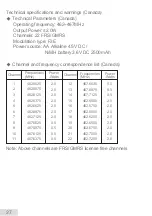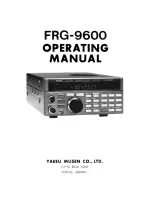
1. Press the button until the power selection menu “Pr”
appears.
2. Press or to select the flashing “HI” or “LO” power.
Note: High power (2 watts) is only available on channels 1-7 and
15-22. Channels 8-14 are restricted to Low power (0.5 watts)
only, in accordance with governmental regulation.
3. Press the PTT button to exit the menu.
High power is indicated on the main display (indicated by “HI”) when
channels 1-7 or 15-22 are selected.
Note: The power setting does not affect the ability of the radio to
receive transmissions. Only the output power is affected by this setting.
Any changes or modifications not expressly approved by the
party responsible for compliance could void the user's authority
to operate the equipment.
This device complies with part 15 of the FCC Rules. Operation
is subject to the following two conditions: (1) This device may
not cause harmful interference, and (2) this device must accept
any interference received, including interference that may
cause undesired operation.
Note: This equipment has been tested and found to comply
with the limits for a Class B digital device, pursuant to part 15
Keypad Tone On/Off
Press and hold the button while turning the radio on to turn the
keypad tone off or back on.
Roger Tone On/Off
Press and hold the button while turning the radio on to turn the
roger beep (PTT transmit beep) off or back on.
Automatic Power Saving
This feature turns off the display automatically when not in use to
save battery life.
Water Activated LED
If the radio is dropped in water, a flashing white LED light will be
activated automatically to assist in finding the dropped radio in
darkness. After retrieving the radio, press any button to
deactivate the flashing light.
ADDITIONAL FEATURES
of the FCC Rules. These limits are designed to provide
reasonable protection against harmful interference in a
residential installation. This equipment generates, uses and can
radiate radio frequency energy and, if not installed and used in
accordance with the instructions, may cause harmful
interference to radio communications. However, there is no
guarantee that interference will not occur in a particular
installation. If this equipment does cause harmful interference to
radio or television reception, which can be determined by turning
the equipment off and on, the user is encouraged to try to
correct the interference by one or more of the following
measures:
• Reorient or relocate the receiving antenna.
• Increase the separation between the equipment and receiver.
• Connect the equipment into an outlet on a circuit different from
that to which the receiver is connected.
• Consult the dealer or an experienced radio/TV technician for help.
Safety Information for Radios
Your wireless handheld portable transceiver contains a low power
transmitter. When the talk button is pushed, it sends out radio
frequency (RF) signals. The device is authorized to operate at a
duty factor not to exceed 50%. In August 1996, the Federal
Communications Commissions (FCC) adopted RF exposure
guidelines with safety levels for handheld wireless devices.
Important
FCC RF Exposure Requirements: For body-worn operation, this
radio has been tested and meets the FCC RF exposure guidelines
when used with accessories supplied or designated for this product.
Use of other accessories may not ensure compliance with FCC RF
exposure guidelines. Use only the supplied antenna. Unauthorized
antennas, modifications or attachments could damage the
transmitter and may violate FCC regulations.
Normal Position
Hold the transmitter approximately 25 mm from your face and
speak in a normal voice, with the antenna pointed up and away.
12
Summary of Contents for SCOUT 2W
Page 56: ......






